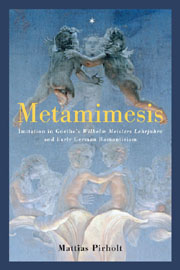Book contents
- Frontmatter
- Contents
- Acknowledgments
- List of Abbreviations
- Introduction
- 1 Romanticism, Mimesis, and the Novel
- 2 Double-Entry Imagery: Johann Wolfgang Goethe's Wilhelm Meisters Lehrjahre
- 3 Imitation and Indolence: Friedrich Schlegel's Lucinde
- 4 Imitation and Simulation: Novalis's Heinrich von Ofterdingen
- 5 Beyond Romantic Representation: Clemens Brentano's Godwi
- Conclusions: Mimesis and the Critical Politics of Romanticism
- Bibliography
- Index
2 - Double-Entry Imagery: Johann Wolfgang Goethe's Wilhelm Meisters Lehrjahre
Published online by Cambridge University Press: 05 February 2013
- Frontmatter
- Contents
- Acknowledgments
- List of Abbreviations
- Introduction
- 1 Romanticism, Mimesis, and the Novel
- 2 Double-Entry Imagery: Johann Wolfgang Goethe's Wilhelm Meisters Lehrjahre
- 3 Imitation and Indolence: Friedrich Schlegel's Lucinde
- 4 Imitation and Simulation: Novalis's Heinrich von Ofterdingen
- 5 Beyond Romantic Representation: Clemens Brentano's Godwi
- Conclusions: Mimesis and the Critical Politics of Romanticism
- Bibliography
- Index
Summary
Indem der Künstler irgend einen Gegenstand der Natur ergreift, so gehört dieser schon nicht mehr der Natur an, ja man kann sagen: daß der Künstler ihn in diesem Augenblicke erschaffe, indem er ihm das Bedeutende, Charakteristische, Interessante, abgewinnt, oder vielmehr erst den höhern Wert hineinlegt. (MA 6.2, 17)
Over the course of time, as more and more of the unpublished material of the Jena romantics — fragments, letters, annotations, diaries — has been made available, it has become abundantly clear that Goethe's Wilhelm Meisters Lehrjahre constituted nothing less than an aesthetic earthquake, comparable to the French Revolution and Fichte's Wissenschaftslehre as it says in one of Friedrich Schlegel's fragments (KA II, 198). However, it has also become obvious that the members of the young generation of writers (August Wilhelm and Friedrich Schlegel, Novalis, and Tieck, among others) were extremely ambivalent about Goethe's novel — a natural reaction, it would seem, to the overwhelming impression it had made on them. There seemed to be a need for dissociation and critique. Although construed as both modern and poetic, Wilhelm Meister still did not qualify as a romantic novel; it lacked the kind of “arabesque unity” that Schlegel found in, say, Cervantes and Tieck.
The official version of the romantic reception of Wilhelm Meister is, of course, Friedrich Schlegel's extensive essay, “Über Goethes Meister,” published in the first volume of the Athenaeum in 1798. Along with countless fragments referring to Goethe's novel, the essay contributed to the romantic apotheosis of this particular work.
- Type
- Chapter
- Information
- MetamimesisImitation in Goethe's 'Wilhelm Meisters Lehrjahre' and Early German Romanticism, pp. 41 - 79Publisher: Boydell & BrewerPrint publication year: 2012



